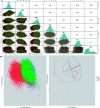Detecting early stage structural changes in wild type, pathogenic and non-pathogenic prion variants using Markov state model
- PMID: 35519320
- PMCID: PMC9064127
- DOI: 10.1039/c9ra01507h
Detecting early stage structural changes in wild type, pathogenic and non-pathogenic prion variants using Markov state model
Abstract
The conversion of prion protein from normal to scrapie followed by the aggregation and deposition of this scrapie form leads to various neurodegenerative diseases. A few studies carried out by researchers suggest that E219K prion mutant (glutamate to lysine mutation at residue position 219) is more stable than wild type protein. However a similar point mutation E200K (glutamate to lysine mutation at residue position 200) is pathogenic. In this study we have carried out detailed atomistic simulation of the wild type, pathogenic mutant E200K and E219K mutant which provides more stability. The aim of the study was to detect the early structural changes present in all the three variants which might be responsible for the stability or for their conversion from PrPC to PrPSc. MSM based analyses have been carried out to find out the differences between WT, E200K and E219K systems. Markov state model (MSM) analysis was able to predict the intermediate states which helped to understand the effect of same mutation at two different locations. The MSM analysis was able to show that the extra stability of E219K mutant may be a result of the increase in number of native contacts, strong salt bridges and less random motions. While pathogenicity of E200K mutant can be attributed to loss of some crucial salt-bridge interactions, increased random motions between helix 2 and helix 3.
This journal is © The Royal Society of Chemistry.
Conflict of interest statement
There are no conflicts to declare.
Figures








Similar articles
-
Conformational polymorphism of wild-type and mutant prion proteins: Energy landscape analysis.Proteins. 2002 Jun 1;47(4):458-68. doi: 10.1002/prot.10095. Proteins. 2002. PMID: 12001224
-
Common structural traits across pathogenic mutants of the human prion protein and their implications for familial prion diseases.J Mol Biol. 2011 Aug 19;411(3):700-12. doi: 10.1016/j.jmb.2011.06.008. Epub 2011 Jun 12. J Mol Biol. 2011. PMID: 21689662
-
High hydrophobic amino acid exposure is responsible of the neurotoxic effects induced by E200K or D202N disease-related mutations of the human prion protein.Int J Biochem Cell Biol. 2011 Mar;43(3):372-82. doi: 10.1016/j.biocel.2010.11.007. Epub 2010 Nov 19. Int J Biochem Cell Biol. 2011. PMID: 21094273
-
Prion encephalopathies of animals and humans.Dev Biol Stand. 1993;80:31-44. Dev Biol Stand. 1993. PMID: 8270114 Review.
-
Familial Creutzfeldt-Jakob disease. Codon 200 prion disease in Libyan Jews.Medicine (Baltimore). 1997 Jul;76(4):227-37. doi: 10.1097/00005792-199707000-00001. Medicine (Baltimore). 1997. PMID: 9279329 Review.
Cited by
-
Drug repurposing studies targeting SARS-CoV-2: an ensemble docking approach on drug target 3C-like protease (3CLpro).J Biomol Struct Dyn. 2021 Sep;39(15):5735-5755. doi: 10.1080/07391102.2020.1792344. Epub 2020 Jul 17. J Biomol Struct Dyn. 2021. PMID: 32679006 Free PMC article.
-
Recognition Mechanisms between a Nanobody and Disordered Epitopes of the Human Prion Protein: An Integrative Molecular Dynamics Study.J Chem Inf Model. 2023 Jan 23;63(2):531-545. doi: 10.1021/acs.jcim.2c01062. Epub 2022 Dec 29. J Chem Inf Model. 2023. PMID: 36580661 Free PMC article.
-
Prion protein E219K polymorphism: from the discovery of the KANNO blood group to interventions for human prion disease.Front Neurol. 2024 Jul 10;15:1392984. doi: 10.3389/fneur.2024.1392984. eCollection 2024. Front Neurol. 2024. PMID: 39050130 Free PMC article. Review.
-
Preventive or promotive effects of PRNP polymorphic heterozygosity on the onset of prion disease.Heliyon. 2023 Feb 24;9(3):e13974. doi: 10.1016/j.heliyon.2023.e13974. eCollection 2023 Mar. Heliyon. 2023. PMID: 36915552 Free PMC article.
References
LinkOut - more resources
Full Text Sources

